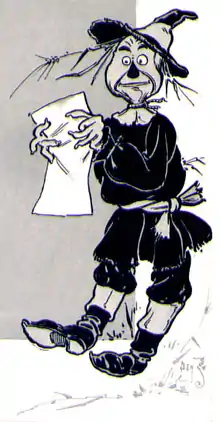Scarecrow (Oz)
The Scarecrow is a character in the fictional Land of Oz created by American author L. Frank Baum and illustrator W.W. Denslow. In his first appearance, the Scarecrow reveals that he lacks a brain and desires above all else to have one. In reality, he is only two days old and merely naïve. Throughout the course of the novel, he proves to have the brains he seeks and is later recognized as "the wisest man in all of Oz," although he continues to credit the Wizard for them. He is, however, wise enough to know his own limitations and all too happy to hand the rulership of Oz, passed to him by the Wizard, to Princess Ozma, and become one of her trusted advisors, though he typically spends more time having fun than advising.
In The Wonderful Wizard of Oz
In Baum's classic 1900 novel The Wonderful Wizard of Oz, the living scarecrow encounters Dorothy Gale in a field in the Munchkin Country while she is on her way to the Emerald City. He tells her about his creation and of how he at first scared away the crows, before an older one realised he was a straw man, causing the other crows to start eating the corn. The old crow then told the Scarecrow of the importance of brains. The "mindless" Scarecrow joins Dorothy in the hope that The Wizard will give him a brain. They are later joined by the Tin Woodman and the Cowardly Lion. When the group goes to the West, he kills the Witch's crows by breaking their necks. He is torn apart by the Flying Monkeys and his clothes thrown up a tree, but when his clothes are filled with straw he is back again. After Dorothy and her friends have completed their mission to kill the Wicked Witch of the West, the Wizard gives the Scarecrow brains (made out of bran, pins and needles – in reality a placebo, as he has been the most intelligent of the group all along). Before he leaves Oz in a balloon, the Wizard appoints the Scarecrow to rule the Emerald City in his absence. He accompanies Dorothy and the others to the palace of the Good Witch of the South Glinda, and she uses the Golden Cap to summon the Winged Monkeys, who take the Scarecrow back to the Emerald City.
His desire for a brain notably contrasts with the Tin Woodman's desire for a heart, reflecting a common debate between the relative importance of the mind and the emotions. Indeed, both believe they have neither. This philosophical debate between the two friends as to why their own choices are superior; neither convinces the other, and Dorothy, listening, is unable to decide which one is right. Symbolically, because they remain with Dorothy throughout her quest, she is provided with both and need not select.[1]
Scholarly interpretations
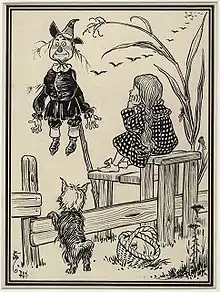 Denslow's drawing of scarecrow hung up on pole and helpless, from first edition of book, 1900 |
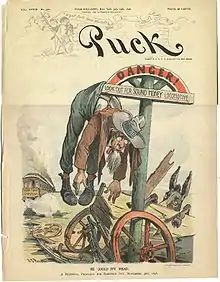 July 1896 Puck cartoon shows farmer hung up on pole and helpless; was this Denslow's inspiration? The hat says "silverite"; the locomotive is gold |
Economics and history professors have published scholarly studies that indicate the images and characters used by Baum and Denslow closely resembled political images that were well known in the 1890s. The Scarecrow, like other characters and elements in The Wonderful Wizard of Oz, was a common theme found in editorial cartoons of the previous decade. Baum and Denslow, like most writers, used the materials at hand that they knew best. They built a story around them, added Dorothy, and added a series of lessons to the effect that everyone possesses the resources they need (such as brains, a heart and courage) if only they had self-confidence. Although it was a children's book, of course, Baum noted in the preface that it was a "modernized" fairy tale as well.
Those who interpret The Wonderful Wizard of Oz as a political allegory often see the Scarecrow, a central figure, as a reflection of the popular image of the American farmer—although he has been persuaded that he is only a stupid hick, he possesses common sense, logic and a quick-wit that needs only to be reinforced by self-confidence.
The blackface minstrel star, Fred Stone, was the first to play the Scarecrow on stage, and he brought his minstrel style of performance to the role of the Scarecrow. Baum was delighted with Stone's performance, and he wrote subsequent Oz books with Stone's minstrel-style in mind.[2]
Later Oz books
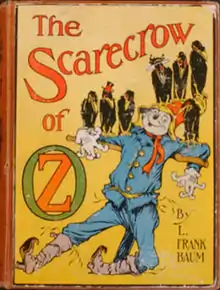
The Scarecrow also appears in other Oz books, sharing further adventures with Dorothy and her friends. His reign as king of the Emerald City ends in The Marvelous Land of Oz when General Jinjur and her Army of Revolt oust him in a coup. He manages to escape the palace and joins Tip and his companions in seeking the aid of Glinda the Good.
He spars with H. M. Woggle-Bug T. E. on the value of education. Although he claims to be educated himself and to value education, he finds the Woggle-Bug's learning rote and without wisdom. Although he cannot eat, he tells Billina that she might be better cooked and generally seems to favor the use of animals as food, sometimes making snide remarks to that effect to his animal companions, although he himself only gathers nuts and fruit for his traveling companions, such as Dorothy and Tip, to eat.
By The Road to Oz he is acknowledged, at least by the Tin Woodman, to be "probably the wisest man in all Oz," and this is the caption of an illustration, suggesting that the reader take his comment at face value. Dorothy herself, in Dorothy and the Wizard in Oz, praises the Scarecrow's wisdom and says the Scarecrow seemed just as wise before the Wizard gave him brains as after.
In The Emerald City of Oz, the Scarecrow lives in a house shaped like an ear of corn in Winkie Country. In The Scarecrow of Oz, the Scarecrow travels to Jinxland, where he helps Cap'n Bill, Trot and Button-Bright overthrow the villainous King Krewl.
In Glinda of Oz the Scarecrow serves as Regent to Ozma of Oz, demonstrating that he is Ozma's third in command. Mostly all he does is play croquet until Ozma's advisers, including himself, band together for a rescue operation.
In The Royal Book of Oz by Ruth Plumly Thompson, Baum's authorized successor as "Royal Historian of Oz", Professor Woggle-Bug accused the Scarecrow of having no ancestry, so he returns to the pole at the cornfield where he was once hung. Sliding down it and descending underground, he first encounters the Midlings and then the Silver Islands, whose people believe themselves to be the ancestors of the Chinese. Apparently, when Emperor Chang Wang Woe defeated the king of the Golden Islands in battle, the king hired a sorcerer to sneak into the palace and transform the Emperor into a crocus, which later sprouted into a bean pole, preceding a prophecy that the first being to touch the bean pole would become possessed by the spirit of the Emperor. As it turned out, the first thing to touch the pole was the straw-stuffed human, which would become the Scarecrow. This account is not consistent with the Scarecrow's story in The Wonderful Wizard of Oz of becoming aware of each sense as the relevant organs were painted on his head.
Film portrayals
Early films
The Scarecrow has appeared in nearly every early Oz film, portrayed by different actors each time.
- The Fairylogue and Radio-Plays (1908): Frank Burns
- The Wonderful Wizard of Oz (1910): Robert Z. Leonard
- The Patchwork Girl of Oz (1914): Herbert Glennon
- His Majesty, the Scarecrow of Oz (1914): Frank Moore
- Wizard of Oz (1925): Larry Semon (just a man in disguise)
- The Land of Oz (1932): Donald Henderson
The Wizard of Oz
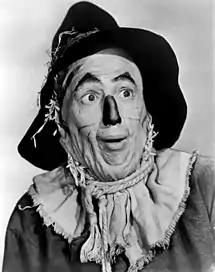
In the 1939 film The Wizard of Oz, the Scarecrow was played by Ray Bolger in what is arguably the actor's most famous role. He was originally cast as the Tin Woodsman, but Bolger had always wanted to play the Scarecrow, he was so upset about it since he wanted to switch roles with Buddy Ebsen, who was originally going to play the Scarecrow. Ebsen didn't mind the swap, so Bolger and Ebsen swapped roles. While Ray was pleased with his role as the Scarecrow, the aluminum dust from Ebsen's Tin Man make-up nearly choked him to death (causing Ebsen to have to give up that role). Ebsen was replaced by Jack Haley for his role of the Tin Man. Bolger's costume consisted of a straw-stuffed suit and a light face mask of rubber designed to simulate burlap. The mask was fragile, and usually had to be completely replaced at the start of each new day of filming.[3] Bolger's Scarecrow costume, minus the mask, is part of the collections of the National Museum of American History at the Smithsonian Institution.[4] Bolger was a talented dancer, so The Scarecrow was given an extended dance sequence in the movie. However, to shorten the movie, much of this sequence was edited out since it would slow down the pace of the film. While Bolger admitted in a 1939 radio broadcast that he was too young to have seen Fred Stone play the Scarecrow in the 1902 musical extravaganza, he told Stone on the broadcast that the first play he was allowed to see was The Red Mill featuring Stone, and that his performance in that play was an inspiration.
During the scene where the scarecrow gets his "brain" (an honorary PhD diploma) from the Wizard he incorrectly recites the Pythagorean theorem, emphasizing that the real gift bestowed upon the characters was confidence in qualities they already possess.
Bolger also portrayed the Scarecrow's Kansas counterpart, Hunk (one of Aunt Em and Uncle Henry's farmworkers), newly created for the film by screenwriter Noel Langley.[5] A scene which was written in the script, but dropped before filming commenced, ended the movie by sending Hunk off to agricultural college, with Dorothy promising to write. The scene implied the potential for a romance between the two characters.
He helps Zeke (Cowardly Lion's alter ego) and Hickory (Tin Man's alter ego) repair a wagon. Unlike Zeke, Hickory and Hunk lose their hats with Uncle Henry as they struggle to open the cellar when the tornado approaches their farm. He closes and locks the cellar with Zeke when Dorothy arrives at the farmhouse. Hunk reunites with Dorothy when she awakens from being unconscious. He is seen with Aunt Em, Uncle Henry, Zeke, Hickory, and Professor Marvel (The Wizard's alter ego).
The Oz Kids
In 1996, they made a cartoon animated The Oz Kids. The Scarecrow now rules the Emerald City and has a son named Scarecrow, Jr. His son is smart and knows everything just like him. Scarecrow, Sr. is voiced by Andy Milder.
Wicked
In the 2003 musical of Gregory Maguire's interpretation of the Oz franchise titled Wicked, this version of the Scarecrow was Fiyero Tigelaar, the love interest of Elphaba Thropp. Fiyero attends school with Elphaba and Glinda the Good, while they were all still young. Fiyero takes a special interest in Elphaba. However, he is highly sought after by Elphaba's roommate, Glinda. Fiyero and Elphaba share a secret romance, and when she leaves for the Emerald City, he gives her a long and meaningful goodbye. Many years later, after Elphaba goes into hiding, we are shown that Glinda and Fiyero are to be wed. However this is not because of love, at least not on Fiyero's part, for he still loves Elphaba. Once she reappears in the Emerald City, they escape together, much to Glinda's discontent. Elphaba then goes to the site of her sister's death (Dorothy's arrival into Oz). Here she is ambushed by guards, and about to be taken away, when Fiyero saves her, but he is merely sacrificing himself to save her. Elphaba in a fit of rage and heartbreak reads a spell to keep Fiyero safe, with the words of the spell including pleas to let him feel no pain and never die however they try to destroy him. Although Elphaba abandons the spell as she believes it is not working, it is not until the end of the production that we are shown that Fiyero is still alive, and has been transformed into the Scarecrow from "The Wonderful Wizard of Oz".
The Scarecrow is also a minor character in author Gregory Maguire's revisionist novel Wicked: The Life and Times of the Wicked Witch of the West and is made a more prominent character in its Broadway musical adaptation Wicked. In the musical, the Scarecrow is revealed to be the remnants of Fiyero after he was captured by the Wizard's officials, but made impervious to injury by Elphaba's incomplete spell. The Fiyero-Scarecrow executes a plan to save Elphaba through using the rumor that water will melt her; thus she stays alive and the two move out of Oz. This has no basis in the book other than that in the final scenes Elphaba hopes that the Scarecrow is really her beloved Fiyero in disguise, which is proven to be a false hope when he is attacked and she sees that he is nothing but straw. The Scarecrow is featured more prominently in Son of a Witch, Maguire's sequel to Wicked. In that novel, the Scarecrow helps the Witch's son Liir avoid political turmoil in the Emerald City after the Wizard's departure. Later, various powerful interests place a different Scarecrow on the throne of Oz to serve as a puppet ruler; the suggestion is that most residents of Oz are unable to distinguish one Scarecrow from another. In the musical, the Fiyero-Scarecrow's appearance and style of walking are based on Bolger's portrayal of the Scarecrow in the 1939 film.
Oz the Great and Powerful
In the 2013 film Oz the Great and Powerful, the Scarecrow's origins are explained; being fabricated by the townspeople of Oz as a diversionary tactic during the retaliatory attack on the Emerald City.[6]
Other adaptations
- In the 1925 film, Wizard of Oz, the Scarecrow and the Tin Man were actually human farmhands, who were blown to Oz by the tornado along with Dorothy. Dorothy, in another major departure from the novel, turns out to be the rightful ruler of Oz, having been exiled to Kansas as a baby.
- In the 1961 animated TV series, Tales of the Wizard of Oz and its sequel, the 1964 NBC animated television special Return to Oz, the Scarecrow (here named Socrates) was voiced by Alfie Scopp.
- Hinton Battle originated the role of the Scarecrow in the 1975 Broadway musical The Wiz, and Michael Jackson played the Scarecrow in the 1978 film adaptation. This version of the Scarecrow was a more tragic character before Dorothy rescues him; while hung on his pole, the crows he is unable to scare, who force him to humiliate himself and entertain them, torment him day and night. They force him to sing the song, "You Can't Win", meaning that he cannot escape the crows' rule and his bad luck. While Stan Winston created Jackson's makeup, it was applied to Jackson's face by Michael R. Thomas who portrayed the Scarecrow in Barry Mahon's The Wonderful Land of Oz (1969), as well as doing the makeup for that film. Elijah Kelley portrayed the Scarecrow in the TV special The Wiz Live!, as well as the farmhand Sticks.
- In the animated film Journey Back to Oz (produced in 1964 but not released until the 1970s), the Scarecrow was voiced by Mickey Rooney.
- In an episode of The World's Greatest Super Friends titled "Planet of Oz," Aquaman temporarily became the Scarecrow after a tornado took him, Superman and Wonder Woman to Mister Mxyzptlk’s Planet of Oz.
- In a 1981 episode of Scooby-Doo and Scrappy-Doo, Shaggy is dressed as the Scarecrow after a tornado took him, Scooby, and Scrappy to "Ahz", a direct spoof of Oz with a different spelling by its enunciation.
- Justin Case, an English bicycle acrobat, appeared briefly as the Scarecrow in the 1985 film Return to Oz. He was turned into an ornament by Nome King. Scarecrow was restored when Dorothy quoted Oz upon touching a green ornament. When Princess Ozma was freed from her mirror prison, Scarecrow allows her to regain the throne.
- A character inspired by the Scarecrow appears in Alan Moore's Lost Girls. In the work, a young farmboy becomes Dorothy Gale's first sex partner. However, she soon grows bored of him because of his lack of intelligence and imagination, comparing it to having sex with something you use to scare the crows. The "scarecrow" tries to prove to Dorothy that he does have a brain and writes her a poem.
- Jackson Browne performed this character in the 1995 television special The Wizard of Oz in Concert: Dreams Come True. The Kansas farmworker Hunk does not appear in this production. Browne sang a folk music tempo of If I Only Had a Brain and the bridge verses sung by the Scarecrow in Nathan Lane's longer version of If I Only Had the Nerve.
- In the 2005 ABC television movie The Muppets' Wizard of Oz, Kermit the Frog plays the role of the Scarecrow. Kermit's other role was himself. Prior to Dorothy's journey, he organizes a talent scout for a star for a new show. After Dorothy's return, he hires her.
- In the 2007 Sci Fi television miniseries Tin Man, the Scarecrow is re-imagined as the character named "Glitch" (played by Alan Cumming). Formerly a chief adviser to the queen of the Outer Zone (O.Z.) named Ambrose, he resists her usurper (and daughter), the evil sorceress Azkadellia and has his brain removed by the physician as a reeducation measure. In the series, he wanders the O.Z. searching for his brain and becomes a companion of the protagonist, a girl named DG.
- In the 2007 VeggieTales episode The Wonderful Wizard of Ha's, the Scarecrow and his Kansas counterpart from the 1939 film were played by Mr. Lunt the Gourd.
- A commercial for GE smart-grid technology, which first aired during the Super Bowl XLIII, featured a computerized Scarecrow dancing clumsily on a radio tower singing "If I Only Had a Brain".
- American voice actor Michael Gough voices the Scarecrow in 2011's direct-to-DVD animated film Tom and Jerry and the Wizard of Oz.
- The Scarecrow appears in the 2012 film Dorothy and the Witches of Oz played by Ari Zigaris. He appears on Earth in the form of a man named Allen Denslow who works as the illustrator of Dorothy Gale's books.
- The Scarecrow appeared in the animated film Legends of Oz: Dorothy's Return (which is based on Dorothy of Oz), voiced by Dan Aykroyd.
- The Scarecrow (along with his other friends from OZ) are playable in the Nintendo 3DS game Code Name: S.T.E.A.M.
- In the 2014 Dorothy Must Die series by Danielle Paige that details a darker depiction of the Land of Oz, the Scarecrow and Dorothy's other companions have been corrupted by their gifts and Dorothy's use of magic. The Scarecrow has become a twisted 'mad scientist', performing various experiments on the animals to turn them into spies or warriors for Dorothy's army, as well as extracting their brains to increase his own. He is 'killed' in the second novel in the series The Wicked Will Rise, when the Wizard takes his brains as part of a plan to bring Oz and Kansas together.
- In Emerald City, a more modern retelling of the series, the Scarecrow equivalent in the series is "Lucas" (portrayed by Oliver Jackson-Cohen) and is an amnesic man who is rescued by Dorothy when she finds him being crucified at the start of her journey. In the course of the film it is revealed that he is actually Rowan, the husband of Glinda, with his amnesia the result of a spell Glinda casts so that he couldn't betray her secrets if he was captured, but the restoration of his memory puts him and Dorothy at odds, as his devotion to Glinda leaves him incapable of recognizing Dorothy's real objections to Glinda's extreme methods to train younger witches. Psychologically torn between his memories as Rowan and his new relationships as Lucas, he eventually forces Dorothy to stab him to stop himself strangling her, culminating in Dorothy leaving him strung up like a scarecrow to symbolically reflect his desire to have never met her. Despite this, he appears in Kansas in the season finale, accompanied by Toto, to ask Dorothy to return with him to Oz.
- The Scarecrow appeared in the Once Upon a Time episode "Our Decay", voiced by Paul Scheer. Many years ago, Zelena the Wicked Witch of the West targeted him for his brain as part of her attempt to create a time-travel spell. Before she can remove Scarecrow's brain, Dorothy and Toto arrived where they managed to get away from Zelena. With help from Hades who enchanted a bicycle that was found at the remains of Dorothy's house, Zelena was able to locate where Dorothy and Scarecrow are hiding. After magically freezing Dorothy, Zelena successfully removed Scarecrow's brain and was about to show it to Hades only to find that he is not there.
- Scarecrow appears in Lego Dimensions, voiced by William Salyers. During the part of the game that takes place in the Land of Oz, Batman mistook Scarecrow for his Scarecrow.
- Scarecrow appears in Lost In Oz, voiced by Stephen Stanton.
- Scarecrow appears in Dorothy and the Wizard of Oz, voiced by Bill Fagerbakke.
- Scarecrow appears in The Lego Movie 2: The Second Part. Alongside Dorothy and the rest of her friends, Scarecrow is somehow transported from the Land of Oz to Harmony Town in the Systar System.
- In the pages of Shazam!, Scarecrow is a resident of the Magiclands location called Wozenderlands. He and the Munchkins find some of the Shazam Family in their part of Wozenderlands. When Billy Batson, Mary Bromfield, and C.C. Batson are teleported to Wozenderlands, they are taken by Scarecrow and the Munchkins to meet with Dorothy Gale. Scarecrow stated that Dorothy Gale and Alice united the Land of Oz and Wonderland to save them from the threats that came from the Monsterlands. They are attacked by Cheshire Cat near the Blue Brick Road that goes through the Queen of Hearts' forest causing Billy and Mary to drive him off. When Mamaragan appeared and also teleported the rest of the foster siblings to Wozenderlands, White Rabbit then gives Scarecrow the axe that belonged to the Tin Man while apologizing for what the Queen of Hearts and her Card Soldiers did to him.[7] When Mister Mind has Shazam cast a spell to unite the seven Magiclands, Scarecrow and White Rabbit start to see the effects of it.[8]
References
- L. Frank Baum, Michael Patrick Hearn, The Annotated Wizard of Oz, p 141, ISBN 0-517-50086-8
- Robin Bernstein, Racial Innocence: Performing American Childhood from Slavery to Civil Rights, (New York: New York University Press, 2011), 159-168.
- "Scarecrow from "The Wizard of Oz"". National Museum of American History. Retrieved 2008-05-22.
- "Treasures of American History: The Wizard of Oz". National Museum of American History. Retrieved 2011-06-29.
- http://www.witness.co.za/index.php?showcontent&global%5B_id%5D=73897
- Allport, Lee (8 March 2013). "Oz the Great and Powerful: A Prequel at Its Best". Retrieved 10 March 2013.
There are other interesting "that explains it" moments as well. We get up close and personal with The Cowardly Lion and find out what spooked him into being afraid of his own shadow. We get to know the Tin Man's father and the creators of the Scarecrow and learn more about Munchkinland.
- Shazam! Vol. 3 #8-9. DC Comics.
- Shazam! Vol. 3 #13. DC Comics.
- Culver, Stuart (1988). "What Manikins Want: The Wonderful Wizard of Oz and The Art of Decorating Dry Goods Windows and Interiors". Representations. 21: 97–116. doi:10.1525/rep.1988.21.1.99p02045.
- Dighe, Ranjit S., ed. (2002). The historian's Wizard of Oz: reading L. Frank Baum's classic as a political and Monetary Allegory. ISBN 0-275-97418-9.
- Green, David L. and Dick Martin. (1977) The Oz Scrapbook. Random House.
- Hearn, Michael Patrick, ed. (2000). The Annotated Wizard of Oz. W. W. Norton & Company. ISBN 0-393-04992-2.
- Riley, Michael O. (1997). Oz and Beyond: The Fantasy World of L. Frank Baum. University of Kansas Press. ISBN 0-7006-0832-X.
- Ritter, Gretchen (August 1997). "Silver slippers and a golden cap: L. Frank Baum's The Wonderful Wizard of Oz and historical memory in American politics". Journal of American Studies. 31 (2): 171–203. doi:10.1017/s0021875897005628. JSTOR 27556260.
- Rockoff, Hugh (August 1990). "The 'Wizard of Oz' as a Monetary Allegory". Journal of Political Economy. 98 (4): 739–760. doi:10.1086/261704. JSTOR 2937766. S2CID 153606670.
- Sunshine, Linda. All Things Oz (2003)
- Swartz, Mark Evan (2000). Oz Before the Rainbow: L. Frank Baum's "The Wonderful Wizard of Oz" on Stage and Screen to 1939. The Johns Hopkins University Press. ISBN 0-8018-6477-1.
- Velde, Francois R. "Following the Yellow Brick Road: How the United States Adopted the Gold Standard" Economic Perspectives. Volume: 26. Issue: 2. 2002. also online here
- Ziaukas, Tim. "100 Years of Oz: Baum's 'Wizard of Oz' as Gilded Age Public Relations" in Public Relations Quarterly, Fall 1998
| Wikimedia Commons has media related to Scarecrow (Oz). |
| Preceded by The Wizard of Oz |
Monarch of Oz | Succeeded by Jinjur |
